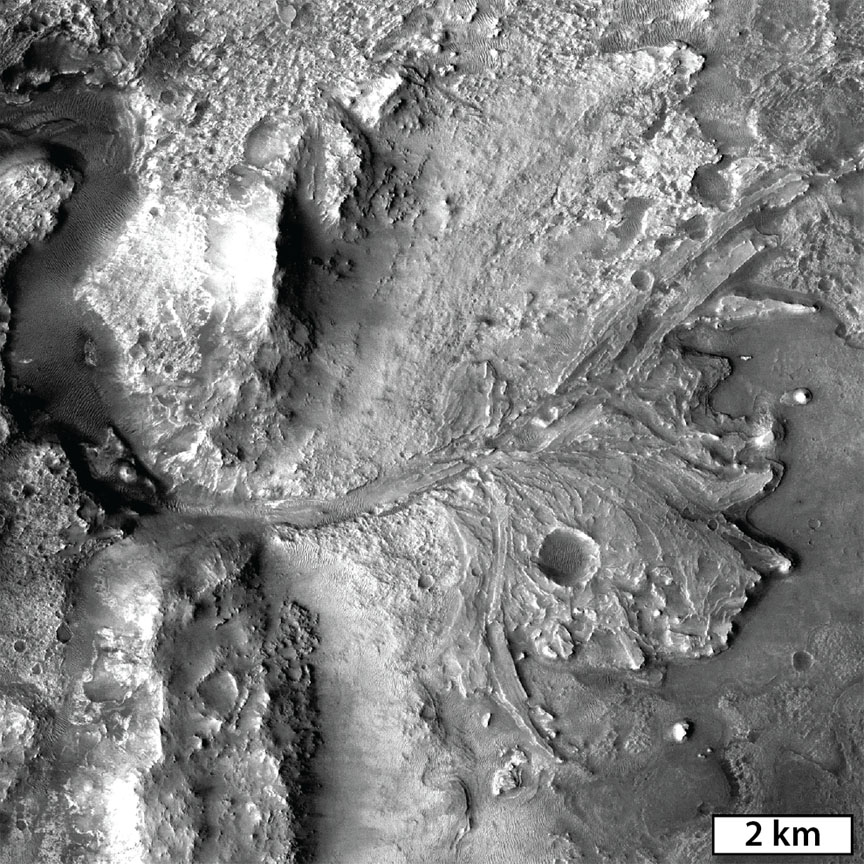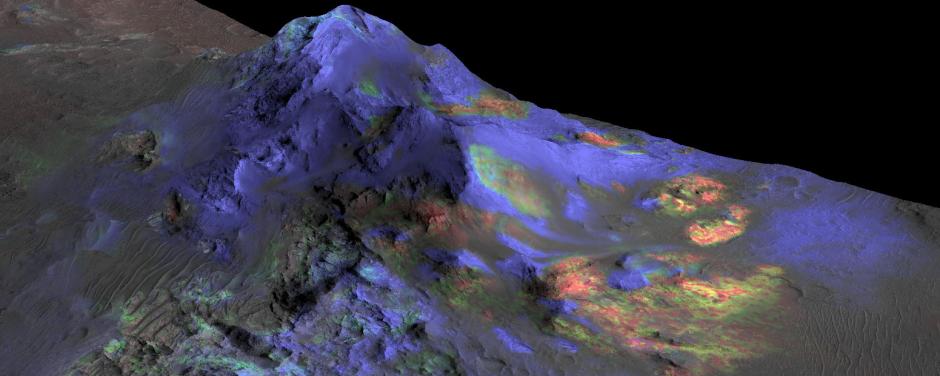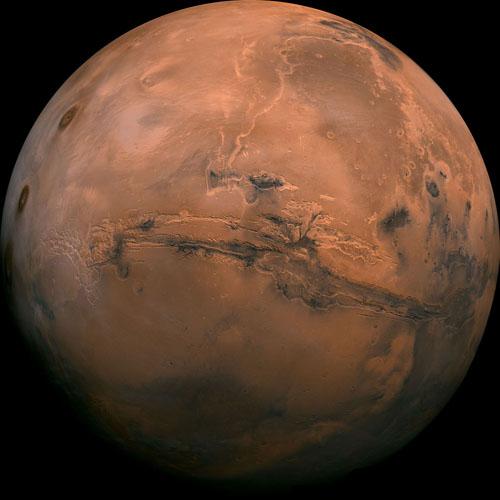PROVIDENCE, R.I. [Brown University] — NASA’s Mars exploration team is looking for a good spot to land a new rover, and Brown University geologists are right in the thick of the process.
The new rover, scheduled for launch in 2020, is designed to look for signs of past life on the Red Planet and to collect samples for possible future return to Earth.
This week, NASA held the second in a series of landing site workshops for the mission. Three Brown geoscientists — Jack Mustard, recent Ph.D. recipient Tim Goudge, and graduate student Kevin Cannon — were there advocating for sites they think are best suited to the mission’s scientific objectives.
“The sites we’re proposing are ones that Brown students and faculty have been working on — and providing real leadership on — for many years,” Mustard said. There’s still a long way to go in the process, but as the nominating contest reaches its second round, the Brown researchers’ sites are currently sitting near the top of the list.
The landing site selection process kicked off in earnest last year. NASA put out a call for proposed sites, and around 30 of them were included in the first landing site workshop, held in May 2014. At the workshop, the proposal submitters gave presentations making the case for their sites, and all in attendance voted on which sites were the most promising. Four of the sites presented at the workshop were ones that Brown researchers had proposed. When the votes were tallied, the Brown sites were the top four.
NASA used its orbital spacecraft to take a closer look at the highly ranked sites from the first workshop and winnowed the contenders down to around two dozen. One of the Brown sites has been pushed down the list for engineering reasons (too many steep sand dunes for roving), but Mustard, Goudge, and Cannon attended the second workshop to make their case again. When the votes were tallied, the Brown sites were ranked first, third, and sixth. Based in part on this workshop, NASA expects to cut the list down to eight. Mission managers are expected to make the final selection in the next few years.
“It’s really a neat process to be a part of,” said Goudge, who also presented at the first workshop. He says he’s impressed with the openness of the process.
“Everyone is afforded the opportunity of voicing an opinion, and your clout doesn’t matter,” he said. “No matter how big a name you are, if your site’s not good ... tough.”
That was also true in the case of the Curiosity rover, which is now making its way up a mountain in the middle of its Gale crater landing site. Ralph Milliken is now a professor at Brown, but he was fresh out of graduate school and working as a postdoctoral researcher when he helped make the case successfully for Gale during the Curiosity mission preparation.
“It doesn’t matter if you’re a full professor or senior research scientist,” Milliken said. “At the end of the day the community recognizes that it really is the science that matters. The key is that the science questions at the site mesh with the payload of that rover and its science goals.”
In the case of the 2020 rover, that means finding a spot with potentially habitable environments and a rich geologic history. Since samples collected during the mission will be stashed on the surface for potential future return to Earth, a wealth of interesting rock samples is also a must.
Mustard is well-acquainted with those science objectives. He was chair of the Science Definition Team for the Mars 2020 Rover, and played a key role in formulating the mission’s science goals.
Brown’s sites
Mustard’s horse in the site-selection race is a region called Northeast Syrtis Major. It’s a little like a Martian Monument Valley, Mustard says, with huge mesas dotting the landscape. The geology of the region is diverse, and numerous spots have potential for past habitability. The region is rich in the mineral olivine, but there are spots where the olivine has been altered to carbonate, and that’s a key process, Mustard says.
“That conversion from olivine to carbonate liberates hydrogen, which could have been an energy source for ancient microbes,” he said. “So there’s the smorgasbord. Ancient microbes could have dined on that and been happy.”
The region also has samples of the very early Martian crust, large volcanic deposits, and impact material from the site of a colossal impact that formed the nearby Isidis basin. All of these features could help scientists piece together the geological history of Mars.

Two ancient rivers fed an ancient Martian lake — a likely place for any organic material to reside. Image: NASA/MSSS/ASU/GSFC
Goudge is making the case for Jezero Crater, which was once home to an ancient Martian lake. The marquee feature at Jezero is a large delta-like deposit where two ancient rivers fed the lake. Orbital data have shown that the delta is rich in hydrated minerals carried in from the surrounding watershed.
“Deltaic deposits on Earth are traditionally thought of as one of the best places to concentrate and preserve organic matter,” Goudge said. “You’re collecting all of this material from a huge watershed and dumping it into one place. You’re also trapping it very quickly so lots of organic material could be well preserved.”
Goudge and colleagues from Brown and elsewhere recently completed a thorough geological analysis of the paleolake system at Jezero, so mission planners would have an excellent sense of where to rove and what to look for.
Cannon ipresented the northern Nili Fossae trough — a groove nearly 20 miles wide that stretches nearly 400 miles across the Martian surface. The trough exposes some of the planet’s oldest crustal material, and its mineralogy suggests alteration by water and possibly an ancient system of hydrothermal vents. All of that suggests a once-habitable environment. The site is also expected to contain material blasted out from an impact that formed Hargraves crater, which is nearby. Cannon showed recently that Hargraves contains impact glass, which has been shown to preserve organic material here on Earth.
“You’re landing on this ejecta from Hargraves crater that’s spilling into the trough,” Cannon said. “So you have the possibility of material preserved inside the ejecta.”
Workshop participants will hear presentations on these and about 20 other potential sites. They’ll vote Thursday to determine the top eight.

Impact glass that could preserve organic material has been found in many craters on Mars, including Alga crater, above. One such glassy crater, called Hargraves, is close to a proposed landing site: Nili Fossae trough. Image: NASA/JPL-Caltech/JHUAPL/University of Arizona
Jim Head, a Brown geologist who helped select landing sites for the Apollo missions to the Moon, is following the process closely. One of the mission objectives for 2020 is to investigate the technology needed for future human exploration of Mars. Head will be part of a workshop in October that begins the process of landing site selection for future human missions to Mars.
“What we learn from the 2020 rover will be important,” Head said. “It's great to see Brown so well represented in the process.”
While he certainly hopes his site is still standing at the end, Goudge says he’s enjoying just being part of the process.
“The workshops themselves are really enjoyable just because of the depth of the science,” Goudge said. “It’s a relatively small group, and people have invested a lot of time and effort into these sites. People show up with their A-game.”

